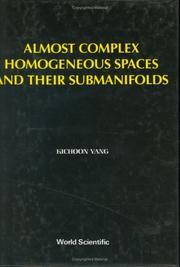| Listing 1 - 4 of 4 |
Sort by
|

ISBN: 9971503778 9789814503235 9814503231 9789971503772 Year: 1987 Publisher: Singapore Teaneck, NJ, USA
Abstract | Keywords | Export | Availability | Bookmark
 Loading...
Loading...Choose an application
- Reference Manager
- EndNote
- RefWorks (Direct export to RefWorks)
This book is an introduction to the theory of almost complex homogeneous spaces and certain closely related class of spaces, so called partial G-flag manifolds. Submanifolds, in particular holomorphic curves, are also treated using the theory of moving frames and the structure theory of compact lie groups. The exposition is reasonably self-contained and this book is strongly recommended as a text for beginning graduate students. Contents: Structures of Compact Lie Groups: Definitions and Examples; Lie Algebras - Basic Results; Orthogonal and Unitary Representations; Maximal Tori and Stiefel Di
Homogeneous spaces --- Submanifolds --- 514.763.4 --- 514.763.4 Manifolds with complex or almost-complex structure. Hermitian manifolds. Kähler manifolds --- Manifolds with complex or almost-complex structure. Hermitian manifolds. Kähler manifolds --- Geometry, Differential --- Manifolds (Mathematics) --- Spaces, Homogeneous --- Lie groups --- Submanifolds. --- Homogeneous spaces.

ISBN: 3110144042 Year: 2000 Publisher: Berlin de Gruyter
Abstract | Keywords | Export | Availability | Bookmark
 Loading...
Loading...Choose an application
- Reference Manager
- EndNote
- RefWorks (Direct export to RefWorks)
Conformal geometry --- Discrete groups --- Manifolds (Mathematics) --- 514.763.4 --- Geometry, Differential --- Topology --- Groups, Discrete --- Discrete mathematics --- Infinite groups --- Circular geometry --- Geometry of inverse radii --- Inverse radii, Geometry of --- Inversion geometry --- Möbius geometry --- Geometry --- 514.763.4 Manifolds with complex or almost-complex structure. Hermitian manifolds. Kähler manifolds --- Manifolds with complex or almost-complex structure. Hermitian manifolds. Kähler manifolds --- Differential geometry. Global analysis
Periodical
ISSN: 03214796 27823229 Year: 1970 Publisher: Kaliningrad : Baltiĭskiĭ federalʹnyĭ universitet imeni Immanuila Kanta,
Abstract | Keywords | Export | Availability | Bookmark
 Loading...
Loading...Choose an application
- Reference Manager
- EndNote
- RefWorks (Direct export to RefWorks)
differential geometry --- geometry --- spaces of affine and projective connections --- methods of studying immersed manifolds --- elementary geometry --- manifolds with a complex or almost complex structure --- Geometry, Differential. --- Differential geometry --- Mathematical Sciences --- Applied Mathematics --- Geometry, Differential --- Géométrie différentielle.
Book
ISBN: 1400885493 9781400885497 9780691170350 9780691176840 0691176841 9780691176840 0691170355 9780691170350 Year: 2017 Publisher: Princeton, NJ
Abstract | Keywords | Export | Availability | Bookmark
 Loading...
Loading...Choose an application
- Reference Manager
- EndNote
- RefWorks (Direct export to RefWorks)
This book provides a short, hands-on introduction to the science of complexity using simple computational models of natural complex systems-with models and exercises drawn from physics, chemistry, geology, and biology. By working through the models and engaging in additional computational explorations suggested at the end of each chapter, readers very quickly develop an understanding of how complex structures and behaviors can emerge in natural phenomena as diverse as avalanches, forest fires, earthquakes, chemical reactions, animal flocks, and epidemic diseases.Natural Complexity provides the necessary topical background, complete source codes in Python, and detailed explanations for all computational models. Ideal for undergraduates, beginning graduate students, and researchers in the physical and natural sciences, this unique handbook requires no advanced mathematical knowledge or programming skills and is suitable for self-learners with a working knowledge of precalculus and high-school physics.Self-contained and accessible, Natural Complexity enables readers to identify and quantify common underlying structural and dynamical patterns shared by the various systems and phenomena it examines, so that they can form their own answers to the questions of what natural complexity is and how it arises.
Complexity (Philosophy) --- Physics --- Computational complexity. --- Complexity, Computational --- Electronic data processing --- Machine theory --- Philosophy --- Emergence (Philosophy) --- Methodology. --- Burridge-Knopoff stick-slip model. --- Gutenberg-Richter law. --- Johannes Kepler. --- Olami-Feder-Christensen model. --- Python code. --- accretion. --- active flockers. --- agents. --- automobile traffic. --- avalanches. --- cells. --- cellular automata. --- chaos. --- clusters. --- complex behavior. --- complex structure. --- complex system. --- complexity. --- computational model. --- computer program. --- contagious diseases. --- criticality. --- diffusion-limited aggregation. --- earthquake forecasting. --- earthquakes. --- emergence. --- emergent behavior. --- emergent structure. --- epidemic spread. --- epidemic surges. --- excitable system. --- flocking. --- forest fires. --- fractal clusters. --- fractal geometry. --- growth. --- hodgepodge machine. --- infection rate. --- iterated growth. --- lattice. --- lichens. --- natural complex system. --- natural complexity. --- natural order. --- natural phenomena. --- nature. --- open dissipative system. --- panic. --- passive flockers. --- pattern formation. --- percolation threshold. --- percolation. --- phase transition. --- planetary motion. --- power-law. --- random walk. --- randomness. --- repulsion. --- rule-based growth. --- sandpile. --- scale invariance. --- segregation. --- self-organization. --- self-organized criticality. --- self-propulsion. --- self-similarity. --- simple rules. --- small-world network. --- solar flares. --- spaghetti. --- spatiotemporal pattern. --- spiral. --- tagging algorithm. --- traffic jams. --- waves. --- wildfire management.
| Listing 1 - 4 of 4 |
Sort by
|

 Search
Search Feedback
Feedback About UniCat
About UniCat  Help
Help News
News